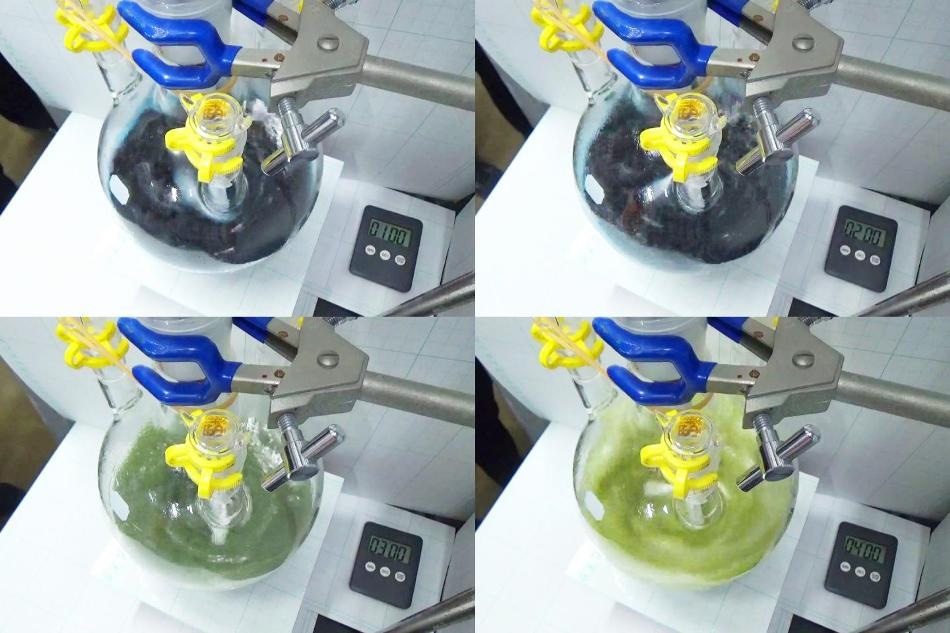Apr 25 2019
Ammonia—a colorless gas used for manufacturing fertilizers—can be produced by a new method that is much easier, cleaner, and cheaper compared to the existing principal method.
 This is the SWAP process in action. It efficiently converts 90% of raw material to ammonia in one go, whereas the Haber-Bosch process only converts 10%. (Image credit: © 2019 Yoshiaki Nishibayashi)
This is the SWAP process in action. It efficiently converts 90% of raw material to ammonia in one go, whereas the Haber-Bosch process only converts 10%. (Image credit: © 2019 Yoshiaki Nishibayashi)
Researchers at the University of Tokyo used recyclable chemicals, readily available laboratory apparatus, and low energy to generate ammonia. Their Samarium-Water Ammonia Production (SWAP) process sets out to reduce ammonia production and improve the accessibility of ammonia fertilizer to farmers worldwide.
In 1900, the world population was below two billion, but in 2019, it is more than seven billion. This increase in the population was stimulated partly by quick developments in food production, particularly the extensive use of ammonia-based fertilizers. The Haber-Bosch process was the source of this ammonia. Although some claim that it is one of the most important everlasting achievements, it is too expensive.
The Haber-Bosch process can convert only 10% of its source material for every cycle; therefore, it has to be carried out several times to completely use the source material. Hydrogen is one of these source materials, which is produced using fossil fuels. This is chemically coupled with nitrogen at approximately 400 °C–600 °C and approximately 100–200 atm, as well as at higher energy cost. Professor Yoshiaki Nishibayashi and his colleagues from the University of Tokyo’s Department of Systems Innovation believe that the situation can be improved with their SWAP process.
Worldwide, the Haber-Bosch process consumes 3 to 5 percent of all natural gas produced, around 1 or 2 percent of the world’s entire energy supply. In contrast, leguminous plants have symbiotic nitrogen-fixing bacteria that produce ammonia at atmospheric temperatures and pressures. We isolated this mechanism and reverse engineered its functional component—nitrogenase.
Yoshiaki Nishibayashi, Professor, Department of Systems Innovation, University of Tokyo
For several years, Nishibayashi and his colleagues used lab-made catalysts to strive and reproduce the way in which nitrogenase reacts. Others have attempted, but their catalysts could only generate from dozens to a few hundred ammonia molecules before they ran out. An exceptional molybdenum-based catalyst used by Nishibayashi produced 4,350 ammonia molecules in about 4 hours before it was consumed totally.
Our SWAP process creates ammonia at 300-500 times the rate of the Haber-Bosch process and at 90 percent efficiency. Factor in the gargantuan energy savings in the process and sourcing of raw materials and the benefits really show.
Yoshiaki Nishibayashi, Professor, Department of Systems Innovation, University of Tokyo
Using appropriate source materials, it is possible to carry out the SWAP process on a tabletop chemistry laboratory, while the Haber-Bosch process needs large-scale commercial equipment. This can potentially support access to those who remained in deficit to invest in such large, expensive equipment. The raw materials themselves are a great saving with respect to energy and cost.
A strong motivation was to make the SWAP process possible on a desktop scale. I hope to see this process democratize production of fertilizers. So it’s not just about the upfront costs but also the continued cost and energy savings of raw materials. My team offers this idea to help agricultural practices in the places which need it the most.
Yoshiaki Nishibayashi, Professor, Department of Systems Innovation, University of Tokyo
SWAP uses N2 from the atmosphere—as the Haber-Bosch process does—but the special molybdenum-based catalyst makes this combine with electrons from samarium (SmI2) and protons from water. At present, samarium—also called Kagan’s reagent—is mined and used in the SWAP process. But samarium can be recycled using electric energy to restore its lost electrons. Scientists have aimed to use affordable renewable sources for this in the future.
I was pleasantly surprised when we found something as common as water could serve as the proton source; a molybdenum catalyst does not normally allow this, but ours is special. It is the first artificial nitrogen-fixing reaction to reach a rate close to that we see nitrogenase produce in nature. And like the natural process, it is passive, too, so better for the environment. I hope my life’s work can be of great benefit to humanity.
Yoshiaki Nishibayashi, Professor, Department of Systems Innovation, University of Tokyo